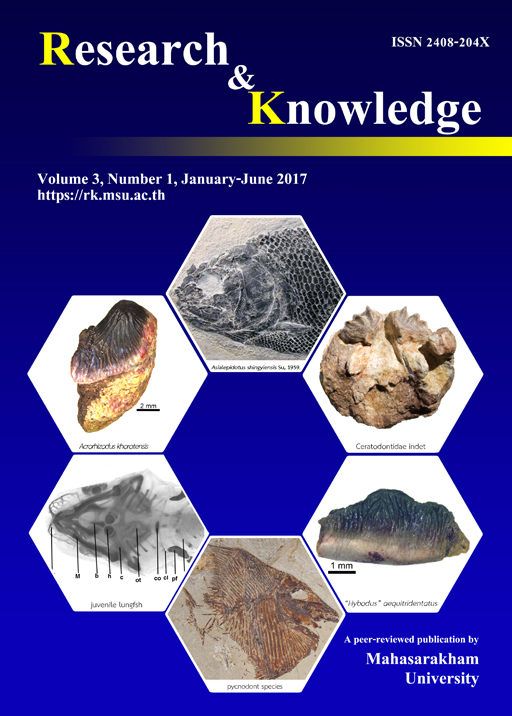Taxonomic revision of Asialepidotus shingyiensis Su, 1959 (Halecomorphi, Holostei) from the Middle Triassic (Ladinian) of Guizhou and Yunnan, China
Keywords:
Triassic, Ionoscopiformes, osteology, phylogeny, South ChinaAbstract
The holostean fish Asialepidotus shingyiensis, from the Middle Triassic (Ladinian) of Guizhou and Yunnan, China, was previously regarded as either a semionotiform ginglymodian or an amiiform halecomorph. This study provides a revision of this taxonomically controversial taxon based on a comparative study including the holotype and 50 new specimens. Newly recognized anatomical information includes the dermal component on the sphenotic, complete series of circumorbital bones, palatal bones, quadratojugal, hyomandibula, sensory canal in the maxilla, notched posterior margin of the maxilla, median gular, and many elements on the medial surface of the lower jaw. Results of a cladistic analysis incorporating these new data place Asialepidotus as an ionoscopiform halecomorph that is more derived than Subortichthys and Panxianichthys, and consists of the sister taxon of Robustichthys and all other ionoscopiforms.
References
Benton, M. J., Zhang, Q. -Y., Hu, S. - X. Chen, Z. -Q., Wen, W., Liu, J., Huang, J. -Y., Zhou, C. -Y., Xie, T., Tong, J. -N. and Choo, B. 2013. Exceptional vertebrate biotas from the Triassic of China, and the expansion of marine ecosystems after the Permo-Triassic mass extinction. Earth-Science Reviews 125, 199–243.
Grande, L and Bemis, W. E. 1998. A comprehensive phylogenetic study of amiid fishes (Amiidae) based on comparative skeletal anatomy: an empirical search for interconnected patterns of natural history. Journal of Vertebrate Paleontology 18 (Suppl), 1–690.
Jin, F. 2009. Fishes. In: Li, J. -L. and Jin, F. (Eds.), Swim in the ocean two hundred million years ago. Ocean Press, Beijing. pp. 99–121.
Liu, G. -B. 2004. Chang names: Guizhoueugnathus, new name for Guizhouella Liu, 2003 and Guizhoubrachysomus, new name for Brachysomus Liu, 2003. Acta Palaeontologica Sinica 43, 447.
Liu, G. -B., Yin, G. -Z., Wang, X. -H., Luo, Y. -M. and Wang, S. -Y. 2003. New discovered fishes from Keichousaurus bearing horizon of Late Triassic in Xingyi of Guizhou. Acta Palaeontologica Sinica 42, 346–366.
Ma, X. -Y. and Xu, G. -H. 2017. A new ionoscopiform fish (Holostei: Halecomorphi) from the Middle Triassic (Anisian) of Yunnan, China. Vertebrata PalAsiatica 55, 92–106.
Su, D. -Z. 1959. Triassic fishes from Kueichow, Southwest China. Vertebrata PalAsiatica 3, 205–210.
Sun, Z. -Y., Tintori, A., Xu, Y. -Z. Cristina, L., Ni, P. -G. and Jiang, D. -Y. 2017. A new non-parasemionotiform order of the Halecomorphi (Neopterygii, Actinopterygii) from the Middle Triassic of Tethys. Journal of Systematic Palaeontology 15, 223–240.
Swofford, D.-L. 2003. PAUP*. Phylogenetic Analysis Using Parsimony (*and Other Methods). Version 4.0b10. Sinauer Associates, Sunderland, Massachusetts.
Xu, G. -H. and Shen, C. -C. 2015. Panxianichthys imparilis gen. et sp. nov., a new ionoscopiform (Halecomorphi) from the Middle Triassic of Guizhou, China. Vertebrata PalAsiatica 53, 1–15.
Xu, G. –H., Zhao, L. –J., and Coates, M. I. 2014. The oldest ionoscopiform from China sheds new light on the early evolution of halecomorph fishes. Biology Letters 10, 20140204.
Downloads
Published
Issue
Section
License

This work is licensed under a Creative Commons Attribution-NoDerivatives 4.0 International License.





